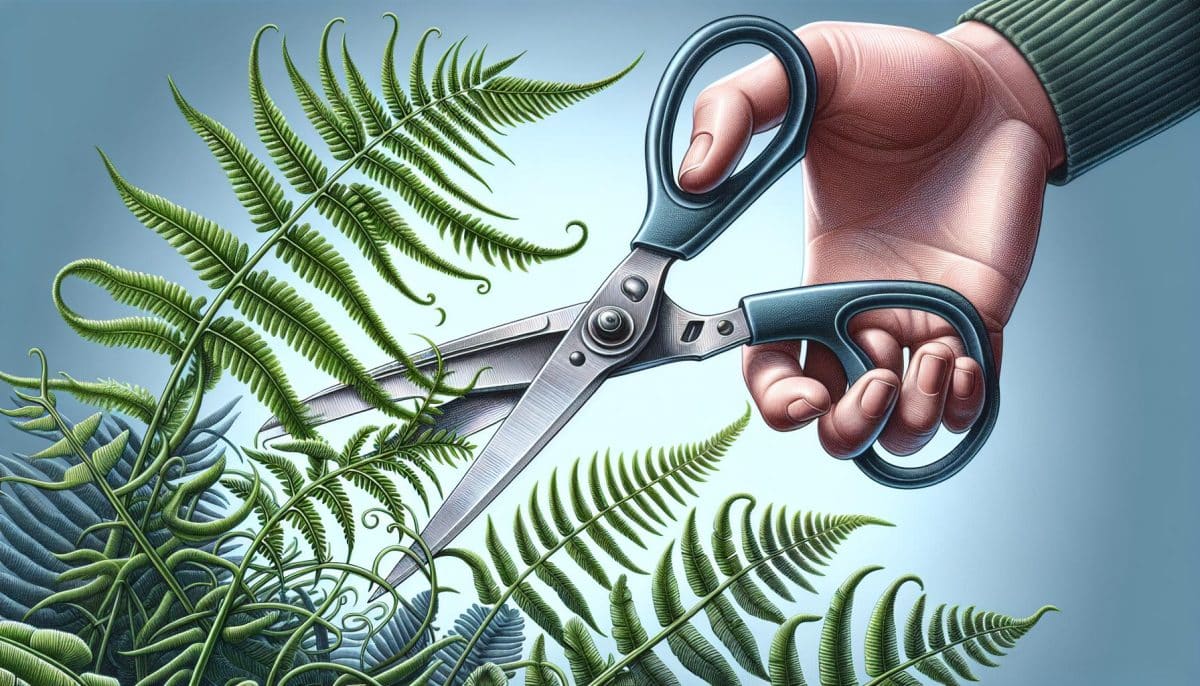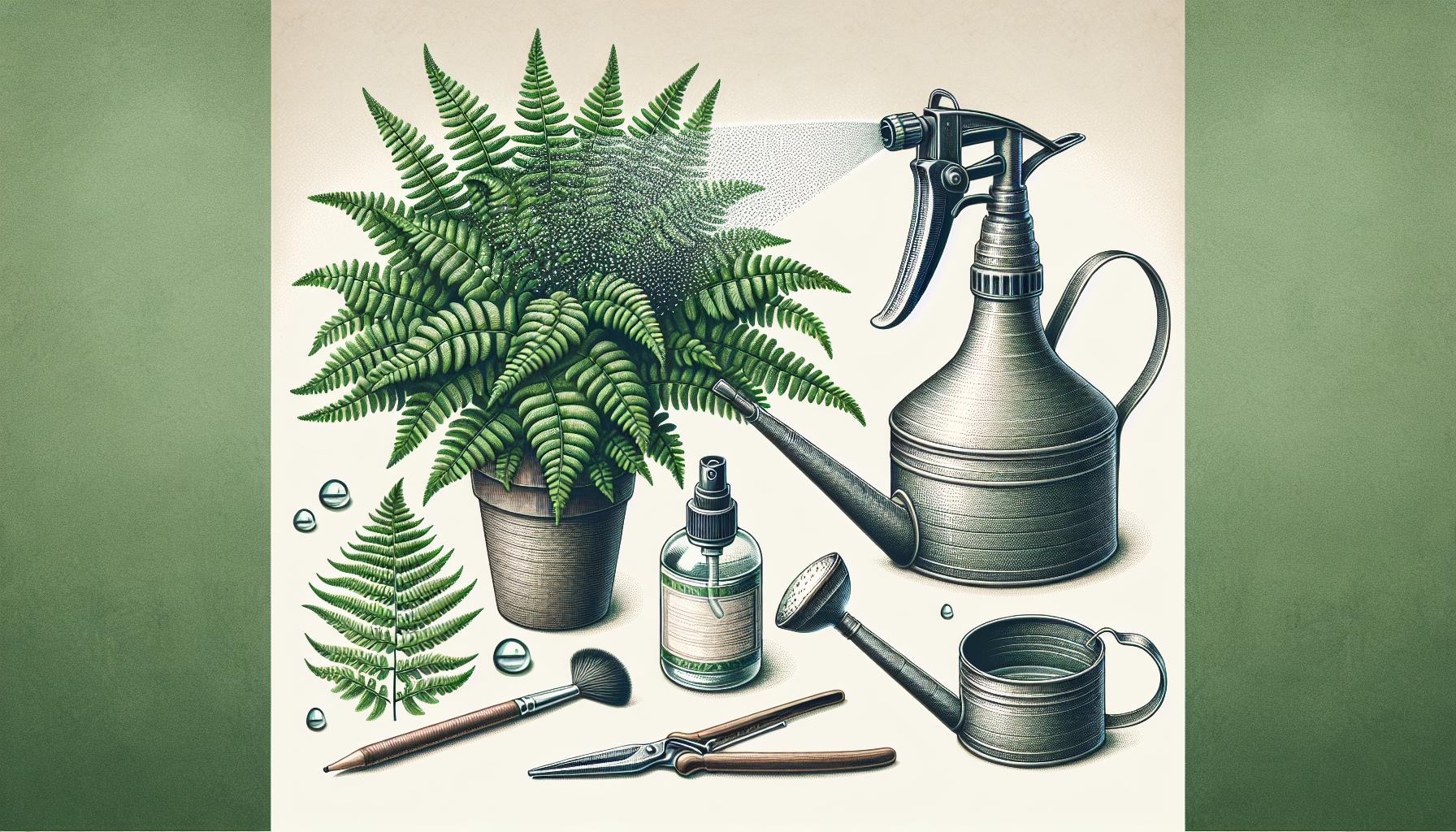
Trimming your ferns isn’t just about keeping up appearances; it’s crucial for their health and vitality. Knowing when and how to give your green friends a trim can ensure they thrive and bring a lush vibe to your space.
Whether you’re a seasoned plant parent or a budding green thumb, mastering the art of fern trimming will make all the difference. Get ready to learn the simple steps to keep your ferns looking their best and growing happily.
Why is trimming fern important?
When you’ve got a fern in your care, maintenance isn’t just about watering and finding the right spot with filtered light. Trimming is vital for ensuring your fern remains an eye-catching part of your home or garden. Here’s why the shears should be part of your fern-care toolkit.
Disease Prevention
Trimming your fern isn’t merely an aesthetic choice—it’s a health requirement. By cutting away dead or brown fronds, you enhance air circulation, which is crucial to keeping your fern free from fungal diseases. Good airflow reduces moisture build-up that can foster such issues.
Promotes Growth
Regular trimming encourages your fern to grow more lush and dense. When you remove older fronds, you redirect the plant’s energy towards producing new, vibrant growth. This is more than mere conjecture; it’s a growth principle seen across the plant kingdom.
Better Absorption
Without adequate trimming, your fern’s older fronds can overshadow the newer ones, limiting their access to light and vital nutrients. Properly thinning out the foliage ensures all parts of the fern get their fair share of resources.
Maintains Shape
Over time, a fern can become leggy and uneven. Strategic trimming keeps the growth balanced, maintaining a pleasing shape that complements your indoor or outdoor space.
When is the best time to trim fern?

Knowing the optimal time to trim your ferns is essential for their health and aesthetic appeal. Early spring is generally the best time to prune ferns. During this season, they are just starting to grow which makes it easier to see and remove any damaged or dead fronds. This timing also coincides with the plant’s natural growth cycle, giving it a chance to recover and flourish throughout the growing season.
Interestingly, some ferns may also benefit from a light trim during late summer or early fall. This can encourage fresh growth and allows you to shape the plant as it prepares for the winter months. However, in doing so, you must ensure that there’s enough time for the new growth to mature before the first frost arrives.
Here are the ideal periods for trimming ferns:
- Early Spring: For removing old growth and encouraging healthy new fronds.
- Late Summer/Early Fall: Optional light trim to tidy up the plant.
Avoid trimming during the winter or late fall as this is when the plant is the most dormant and any new growth could be damaged by frost. Moreover, during the active growth period in summer, it’s best to just remove brown or dead fronds as needed rather than doing any major pruning which can stress the fern.
Pruning your ferns at the right time supports their natural life cycle, ensuring that they remain robust and attractive. Remember to always use clean, sharp tools for trimming to prevent the spread of disease and to make clean cuts that heal quickly.
Tools needed for trimming fern

Before you delve into the task of trimming your ferns, gathering the right tools is essential. Using the proper equipment not only facilitates a smoother pruning process but also ensures the health and longevity of your ferns.
Pruning Shears: Your go-to tool for trimming ferns is a pair of high-quality pruning shears. Ensure they’re sharp and clean to prevent disease and promote quick healing. Whether you’re removing dead fronds or shaping the plant, these shears provide precision and easy handling.
Gloves: Protect your hands with a sturdy pair of gardening gloves. These minimise the risk of scratches and keep your hands clean. Ferns might not be thorny, but the general debris and dirt can cause small nicks and irritation.
Disinfectant: A mild disinfectant for your tools is crucial. Before you start and after you finish, disinfect your shears to eliminate the chance of spreading plant diseases or pests from one fern to another.
Waste Container: As you trim, you’ll want a container or bin close by for the immediate disposal of trimmings. This keeps your workspace clear and prevents the spread of any potential diseases contained in the removed fronds.
Remember, a gentle touch is key when using these tools on your ferns. Their fronds are delicate, and your aim is to enhance growth, not hinder it. With these tools at hand, you’re set to effectively maintain the beauty and health of your fern garden.
Step-by-step guide to trimming fern

When your ferns are looking a bit unruly, it’s time to give them a trim. By following this guide, you’ll ensure they remain healthy and appealing.
Assess the Fern
Before you begin, take a moment to assess your fern. Look for any fronds that are brown, wilted, or dead. These are the ones you’ll need to remove. Healthy green fronds should generally be left alone unless they are overgrown.
Start with Outer Fronds
Begin trimming from the outer edges. These are often the oldest parts of the plant and the most likely to show signs of wear or damage. Use your sharp pruning shears to snip the fronds at the base, close to the soil.
Work Inwards With Care
As you move closer to the centre of the fern, be more selective. Trim only those fronds that are clearly damaged or diseased. Remember, your goal is to enhance the plant’s natural shape, not to create a perfectly symmetrical sphere.
Regular Disinfecting
Between cuts, ensure your shears are clean. Wipe them with a mild disinfectant to prevent any potential spread of disease between plants or different parts of the same plant.
Trim For Growth
Focus on cutting back areas where growth is dense. This will improve air circulation and light penetration to the inner parts of the plant, encouraging new growth.
Key Points to Remember:
- Remove brown, wilted, or dead fronds
- Trim from the outer edges inward
- Use clean, sharp shears to prevent disease
- Enhance the plant’s natural shape
- Improve air circulation for healthy growth
By following these steps, your fern will not only look better but will grow stronger as well. Keep an eye on its development and be ready to trim again when needed.
Tips for maintaining healthy ferns

Adequate Watering is crucial for ferns. Your plants need consistent moisture to thrive, so aim for a balance between keeping the soil moist and avoiding waterlogged conditions which can lead to root rot. Use room temperature water to avoid shocking the plant’s system.
Humidity Levels play a pivotal role in fern health. Ferns originate from moist, humid environments. To replicate these conditions in your home, regularly mist your ferns or use a humidifier to maintain adequate humidity around your plants.
Proper Fertilization supports lush fern growth. Apply a balanced, water-soluble fertilizer monthly during the growing season but scale back in the winter months when growth naturally slows.
Suitable Lighting is essential. Although ferns are commonly thought to require minimal light, they actually need bright, indirect light to prosper. Direct sunlight can scorch the delicate fronds, so position your ferns near windows with sheer curtains or in partially shaded areas.
To ensure Effective Air Circulation, don’t overcrowd your ferns with other plants. Good airflow reduces the risk of pest infestations and disease by helping keep the fronds dry and healthy.
Remember to continuously Inspect Your Ferns for any signs of trouble. Early detection of issues like pests or fungal diseases allows for quicker, more effective treatment. Keep an eye out for discolouration or deformities on the fronds or changes in the soil condition.
Incorporating these tips into your regular fern care routine will bolster the vitality of your plants. Healthy ferns not only display more vigorous growth but are better equipped to recover from the trimming process, ensuring they remain a lush and vibrant part of your indoor garden.
Conclusion
Trimming your ferns is about more than just keeping them looking their best—it’s essential for their health and vitality. By following the steps you’ve learned, you’ll ensure your ferns are not only aesthetically pleasing but also thriving. Remember to stay vigilant and give your plants the attention they deserve. With the right care and regular maintenance, your ferns will continue to add a touch of green elegance to your space for years to come. Happy trimming!
Colin Macmillan is a seasoned entrepreneur and the CEO of Riverwood Landscape, a leading landscaping company based in Canada. He has been at the helm of the company since leaving high school, demonstrating his strong leadership skills and business acumen.
Colin’s expertise lies in various aspects of landscaping, including lawn care, interlocking, sod installation, and commercial maintenance. His hands-on approach and dedication to the craft have been instrumental in building Riverwood Landscape into a reputable brand.
One of his most notable achievements is the creation of a successful landscape franchise that services multiple locations. This accomplishment underscores his strategic thinking and ability to scale operations effectively.
Colin has also had the privilege of working with Guelph Hospital for landscaping and maintenance, a testament to the trust and reliability that his company has earned over the years.
His professional mission is to offer the best services and experiences for customers, a goal that he tirelessly pursues. Colin’s commitment to excellence and customer satisfaction continues to drive the growth and success of Riverwood Landscape.








